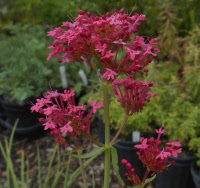"New" Heirloom Plants
Showing 1–8 of 11 results
-
Centranthus ruber Jupiter’s beard, Red Valerian, Pretty Betsy Z 5-8
Clusters of crimson, star-shaped florets atop 2’ stems bloom their heads off ALL summer into fall.
Clusters of crimson, star-shaped florets atop 2’ stems bloom their heads off ALL summer into fall.
Size: 24-36”x 12”
Care: Sun in well-drained alkaline soil, drought tolerant
Native: Mediterranean
Wildlife Value: attracts butterflies, bees and hover flies.Centranthus is from the Greek meaning “spurred flower.” According to Culpepper, an English herbalist from the early 1600’s, this plant comforts the heart and stirs up lust. Parkinson, in 1629 describes it “of a fine red colour, very pleasant to behold.”
-
Cymbalaria muralis Kennilworth ivy, Pennywort Z 4-8
Tiny pink snapdragons all summer
Tiny pink snapdragons all summer
Size: 2-3” x spreading, trailing
Care: full sun to part shade in moist, well drained soil
Native: So. EuropeIntroduced to gardens by the early 1600’s. Southern Europeans ate the plant as a salad. Tournefort reported that it grew “on mud walls, old ruins and upon rocks” in Italy.
-
Ligularia stenocephala Leopard plant Z 4-8
Daisy-shaped buttercup to golden yellow flowers cover narrow, 4-5 ‘tall spikes from late summer to early fall. Its foliage is as arresting as the flowers. Big, rounded-triangular shaped leaves with sharply scissored edges surround the bottom with smaller ones cover the stems until the leaves meet the bottoms of the flower spike.
Daisy-shaped buttercup to golden yellow flowers cover narrow, 4-5 ‘tall spikes from late summer to early fall. Its foliage is as arresting as the flowers. Big, rounded-triangular shaped leaves with sharply scissored edges surround the bottom with smaller ones cover the stems until the leaves meet the bottoms of the flower spike.
Size: 5’ x 5’
Care: part shade in moist soil
Native: China, Taiwan, and Japan
Wildlife Value: a favorite nectar and pollen source for bees and butterflies. Rabbit resistantCollected and first named by Russian botanist Carl Johann Maximowicz (1827 – 1891). St. Peterburg Botanic Garden sent him to South America where he searched for plants around Rio, then crossing Cape Horn he collected in Hawaii. After his ship was commandeered off the coast of China, he crossed China from west to east through China and Siberia recording his specimens that grew along the Amur River. He returned traveling west to east then crossed the East China Sea of the Pacific Ocean to Japan where he collected for four years.
-
Lilium michiganense Michigan lily Z 4-8
The top of each erect stem curves over like a hook. A single red or orange flower dangles from the stem’s tip. Spotted petals (botanically called tepals) curve up with their tips nearly reaching the top of the flower. Stamens hang down from the center then flare out inviting bees and butterflies to its pollen. They flower for nearly a month in mid-summer.
OUT OF STOCK
The top of each erect stem curves over like a hook. A single red or orange flower dangles from the stem’s tip. Spotted petals (botanically called tepals) curve up with their tips nearly reaching the top of the flower. Stamens hang down from the center then flare out inviting bees and butterflies to its pollen. They flower for nearly a month in mid-summer.
Size: 2-5’ x 8-10”
Care: sun to part-shade in moist to moist well-drained, neutral to acidic soil.
Native: New Hampshire west to Wisconsin, south to Arkansas, east to Alabama and Florida
Wildlife Value: attracts hummingbirds, bees, and butterfliesThis had several prior names, as varieties or subspecies of Lilium canadense or Lilium speciosum. In 1915 botanist Oliver Atkins Farwell (1867-1944) renamed it in “Notes of Michigan Liliaceae,” Bulletin of Torrey Botanical Club 42, p. 353, based on one he collected in 1910 in Wiard’s Crossing, Michigan.
-
Philadelphus lewisii Lewis’ Mock Orange Z 4-9
A triple delight. From late spring to early summer clusters of 2” wide, four-petaled, snow-white flowers with a center boss of sunny stamens smother stem ends on this vase-shaped shrub. The flowers perfume the air with a delicious, orange scent. Then in fall the foliage turns citrus-yellow. Idaho adopted this as the state flower.
A triple delight. From late spring to early summer clusters of 2” wide, four-petaled, snow-white flowers with a center boss of sunny stamens smother stem ends on this vase-shaped shrub. The flowers perfume the air with a delicious, orange scent. Then in fall the foliage turns citrus-yellow. Idaho adopted this as the state flower.
Size: 5-10’ x 5-7’
Care: sun to part-shade in moist to well-drained soil
Native: from British Columbia to California, east to Montana.
Wildlife Value: Nectar and pollen attract bumble bees, moths, butterflies and hoverflies. It hosts caterpillars and chrysalises. Many birds eat the seeds.Natives used its strong and hard wood to make arrows, bows, combs, pipes for smoking, snowshoes, clubs, armor to protect chests, fishing spears, harpoon shafts, sticks for digging, knitting needles and baskets. Meriwether Lewis collected this plant on the Lewis & Clark Expedition in two places, in early May 1806 in Nez Perce County Idaho and two months later in Missoula County, Montana.
-
Primula beesiana Candelabra primrose, Bee’s primrose Z 4-8
From 2-8 stems, each bearing a whorl of a dozen or so small, fuchsia-pink flowers encircling each leafless stem like a ballerina’s tutu,, then alternating with a leafless stem, the another whorl of flowers then another section of leafless stem in tiers, Each whorl blooms in succession from the bottom up.
From 2-8 stems, each bearing a whorl of a dozen or so small, fuchsia-pink flowers encircling each leafless stem like a ballerina’s tutu,, then alternating with a leafless stem, the another whorl of flowers then another section of leafless stem in tiers, Each whorl blooms in succession from the bottom up.
Size: 1’ x 1’
Care: part shade in moist or moist well-drained soil in neutral to acidic pH
Native: Sichuan and Yunnan provinces in SW China and Myranmar
Wildlife Value: attracts butterflies, bees and other pollinators
Awards: Royal Horticultural Society Award of Garden MeritPrimula means “first spring” in Italian. The common name “Bee’s” is not for the insect; it’s for the nursery that grew them on and sold them and funded Scottish collector George Forrest’s trip to China to hunt for plants. Forrest collected this around 1910. Naturalist Arthur Bulley (1861-1942) owned that nursery, Bees Ltd.
-
Ranunculus acris Meadow buttercup Z 4-8 POISON
Scads of cheerful cup-shaped, butter-colored blooms atop wiry stems in late spring to early to mid- summer. Flowers taller than the deeply divided foliage into 3-5 hand-shaped lobes, each of which it divided again into more lobes with sharp-shaped tips with tooth-like edges all with prominent veins. Excellent cut flower
Scads of cheerful cup-shaped, butter-colored blooms atop wiry stems in late spring to early to mid- summer. Flowers taller than the deeply divided foliage into 3-5 hand-shaped lobes, each of which it divided again into more lobes with sharp-shaped tips with tooth-like edges all with prominent veins. Excellent cut flower
Size: 18-24” x 12” slowly spreading
Care: Sun to part sun in moist soil
Native: Europe
Wildlife Value: deer resistant, attracts butterflies and bees.Ranunculus is Latin for little frog, so named by Roman Pliny referring to the wet conditions required by some ranunculus. Named by English naturalist John Ray in Historia plantarum, published between 1686 and 1704, in which he classified 18,000 plant species.
-
Rosa xanthina Manchu rose Z 4-9
Semi-double, 2” across, yellow roses, with a musky fragrance, cover graceful, arching stems in May-June. Maroon rose hips in fall.
Semi-double, 2” across, yellow roses, with a musky fragrance, cover graceful, arching stems in May-June. Maroon rose hips in fall.
Size: 8’ x 4-6’
Care: sun to light shade in moist well-drained soil
Awards: Royal Horticultural Society Award of MeritSometime before 1820 Aylmer Lambert (1761-1842), wealthy English collector of pressed plant specimens and just about anything related to plants, acquired a painting of Rosa xanthina from China, That year English botanist and orchid specialist John Lindley (1799-1865) published a description of it from the painting, Rosarum monographia, or, A botanical History of Roses Extraordinary Dutch plant explorer Frank Meyer (1875-1918) introduced the plant to the West. Educated by working in nurseries, with an insatiable curiosity about plants and a wander lust he walked alone throughout western Europe collecting plants. Next in the US he worked for the USDA and walked in California, Cuba, and Mexico. The USDA sponsored Meyer to collect in China, making four trips from 1905 to 1918. In 1907 he sent Rosa xanthina seeds collected near Peking to Harvard’s Arnold Arboretum. He introduced about 2500 plants new to the West. Meyer is best known for his find of a semi-sweet lemon, Meyer lemon. He died of unknown causes during his last trip in China.
**LISTED AS OUT OF STOCK BECAUSE WE DO NOT SHIP THIS ITEM. IT IS AVAILABLE FOR PURCHASE AT OUR RETAIL LOCATION.



